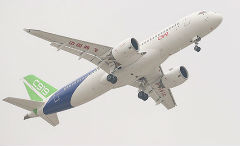Thousands of test hours on C919 jet needed before OK
2017-06-01
China Daily
China will ramp up resources to accelerate the approval process for C919, the country’s first large domestic passenger plane, to obtain an airworthiness certificate, which may require thousands of test flight hours, the industrial regulator and the aircraft’s maker said.
The C919 is scheduled to go through about 729 test projects and 4,200 hours of flight before it obtains the certificate from the Civil Aviation Administration of China. Such a step is imperative for it to enter the commercial market, according to the Commercial Aircraft Corp of China, the C919’s manufacturer.
Li Dong, director of the industrial equipment department at the Ministry of Industry and Information Technology, said that after C919’s successful maiden flight in May, more effort will be made to boost its flight performance, beef up maintenance support and lower its operating cost.
The ministry said it also will leverage the experience China has accumulated in certifying the ARJ21, the nation’s first domestic commercial regional aircraft, to help accelerate the process for the C919. No specific timetable was discussed.
Lin Zhijie, an aviation industry analyst at CARNOC, a major Chinese civil aviation website, said by taking multiple test flights, the C919 aircraft needs to prove it is safe to fly and can meet the operational requirements for commercial use. The ARJ21, for instance, has 3,418 reports showing it meets operational requirements.
Lin said it took six years for the ARJ21 to obtain its airworthiness certificate because it was something no Chinese company had never before attempted. The aviation authority had to design the aircraft approval system from scratch.
“But now, both the manufacturer and authorities have experience, relevant technology and talent. The process for the C919 will take less time,” Lin said
The twin-engine, single-aisle C919, which can carry 158 to 174 passengers, made its first flight in early May. It is part of China’s broad effort to meet soaring domestic travel demand and break the global market duopoly of Boeing and Airbus.
“Since launching the C919 project, China has made more than 100 technological breakthroughs in areas including the integrated design of engines and systems control,” said Li, from the Ministry of Industry and Information Technology. He refuted foreign media reports that China was assembling rather than making an airplane.
He said it is a common international practice in the aviation industry to source components from other companies. Boeing said 65 percent of the cost of its civilian planes goes to paying suppliers.
Aviation Industry Corp of China, a domestic aircraft maker, has set up 16 joint ventures with foreign companies to supply products such as electric power system and braking systems to the C919.
Steven Lien, president of Honeywell Aerospace Asia Pacific, said in an earlier interview that the C919 program represents a $15 billion to $16 billion opportunity for Honeywell over the life of the aircraft program.


